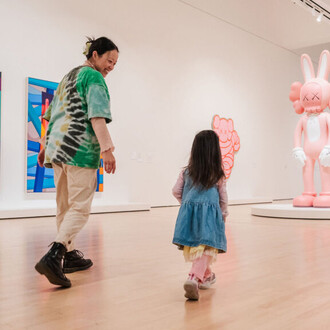Anglim Gilbert Gallery presents Unconscious Rationale: Artists Amend Reality, a group exhibition featuring artists from the gallery. Retuning their awareness they adjust reality, taking inventive pathways to a new vantage point.
Unconscious Rationale’s treasury is rich with a heightened spirit of invention. As visual counterparts to literary fiction, the paintings, sculptures, photographs, prints and mixed media works featured cross the boundaries of realism. Although the artworks may find their origin in a factual situation, the final renderings emerge from an unexpected place in the imagination.
Central to the exploration are two San Franciscan artists of note, Jean and Bruce Conner. Since the 1960’s Jean Conner has crafted trenchant collages from found reproductions, skewing scale and environmental context. Complementing her works with serial distortion are a pair of b/w photographic compositions of punk bands by Bruce Conner.
Several deal in exaggeration and hilarity, others play on anxieties and fears, amplifying dark experiences. Dean Byington’s vertiginous landscape Divided City combines macro and micro in its infinitesimal detail and omniscient perspective. The veracity of the painting’s black-and-white dystopian landscape comes into question when the viewer’s eye meets the horizon, over which looms the sky in color. Tony Oursler’s journeys into the unconscious are represented in two formats: a tiny sculpture populated by captive figures and their demons, and a ‘painting’ embedded with a disarming video face. Terry Allen creates a tribute to Antonin Artaud’s 1936 fantasy voyage to Mexico, where he went looking “for the basis of a magical culture which can still gush forth the forces of the Indian earth” (A. Artaud.)
Brewing together editorial critique and outright fantasy, Enrique Chagoya’s hyperbolic diptych Mano Poderosa, (1992) depicts the universal hand of power that continues, twenty-six years later, to inundate all. Paul Kos’ monument to the Everyman, his giant Pawn, is made up of all of the chess pieces except the pawn, and describes the tiers of society from the King to the army to organized religion.
Richard Shaw’s trompe l’oeil ceramics yield a hyper-realistic view of the ordinary. Freezing the everyday in porcelain, he exalts its timelessness and fragility. Nathaniel Dorsky celebrates the same with the poetic confusion of a film still: the viewer can enjoy the image without recognizing what it is. With synesthetic flair Bruno Fazzolari creates paintings as he would a perfume, allowing color and shape to assume the properties of fragrances. Travis Collinson distorts proportion and perspective, intensifying his painting’s wordless psychological atmosphere.
Within the show is an inventory of the body and its parts, from Lynn Hershman’s ‘Construction Chart’ for the creation of her alter ego Roberta Breitmore and a composite face Bogart/Rowlands, to Benji Whalen’s disembodied eyeballs. Other methods turn figuration on its head, like Katherine Sherwood’s formalized arrangements of the brain and nervous system, or Ken Graves’ delicate collages of men rapt in exercise and dreams. Jerome Caja’s ‘Lone Star’ is a mock machine with a penis (rather than panic) button. Joan Brown’s self portraits substitute the corporeal body with moral attributes (Summer Solstice 1982) and cosmic ether (The Cosmic Nurse 1978), while Judith Linhares takes the figure to its logical conclusion, the skeleton.
















